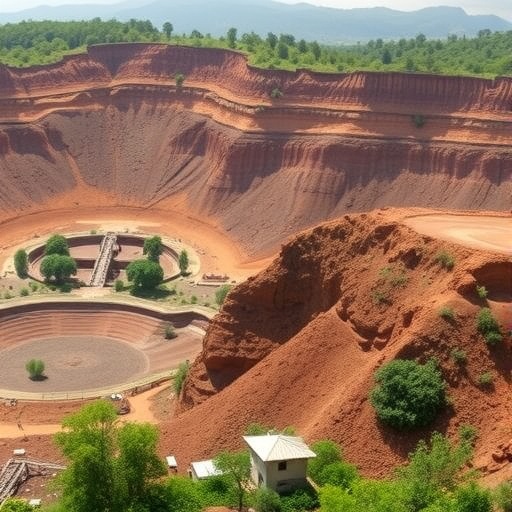Ethiopia, a nation known for its rich cultural heritage and diverse landscapes, has recently gained attention for its burgeoning gold mining industry. This sector, while offering significant economic opportunities, has also sparked a series of environmental challenges that cannot be overlooked. A recent study by H. Meaza published in Discover Sustainability highlights the complex interplay between gold mining practices and land degradation, urging a reconsideration of current methods in the context of sustainable development.
The landscape of Ethiopia is a patchwork of highland plateaus and lowland valleys, making it home to not just a wealth of biodiversity but also numerous mineral resources. The country’s gold reserves are significant, and in recent decades, there has been a considerable thrust towards mining as a catalyst for national development. However, as Meaza’s research illustrates, this developmental path has often resulted in extensive land degradation, threatening the very resources that communities rely on for their livelihoods.
Gold mining has become a double-edged sword, offering employment and economic growth while simultaneously causing detrimental impacts on the environment. Meaza emphasizes that the traditional methods of extraction tend to disregard ecological balance, resulting in soil erosion, loss of arable land, and disruption of local ecosystems. When land is stripped of its natural vegetation for mining operations, it loses its ability to retain moisture and support agriculture, which many rural communities depend upon.
Furthermore, the effluent produced during gold processing poses an additional threat to both terrestrial and aquatic ecosystems. Heavy metals and toxins can leach into the soil and waterways, raising concerns about the health implications for local populations. As communities increasingly confront environmental degradation, the urgency for sustainable land restoration practices becomes paramount. Meaza’s work highlights the need for a framework that prioritizes both economic development and ecological preservation.
Sustainable land restoration techniques can provide a way forward. Methods such as reforestation, soil health management, and the rehabilitation of mined-out areas not only restore the environmental balance but also enhance the resilience of local communities. Meaza points out that incorporating local knowledge and practices into restoration efforts can lead to more effective outcomes. When communities are involved in decision-making processes, they are more likely to support and participate in sustainability initiatives.
The research also underscores the role of policymakers in shaping the direction of the gold mining industry. By enforcing stringent regulations and promoting sustainable practices, the government can mitigate the adverse effects of mining while still fostering industrial growth. Meaza calls for the establishment of policies that encourage the adoption of eco-friendly mining technologies, which can reduce the environmental impact significantly.
Moreover, there is a pressing need for education and awareness-raising among miners and local communities about the importance of sustainable practices. Training programs that focus on both the economic and environmental aspects of gold mining can empower stakeholders to make informed decisions. By understanding the long-term benefits of sustainability, individuals and communities may be more inclined to support practices that protect their environment.
International collaborations may also play an integral role in addressing the challenges posed by gold mining in Ethiopia. By leveraging global expertise and resources, initiatives can be designed to support local efforts in sustainable land management. This includes sharing best practices from other countries that have faced similar challenges, creating a global network of knowledge and support dedicated to sustainable development in mining industries.
In conclusion, the current state of gold mining in Ethiopia is a compelling case study of the intricate balance between economic development and environmental sustainability. As the country continues to navigate this path, Meaza’s research stands as a crucial reminder of the need for urgent action in restoring and preserving Ethiopian lands. The future of both the mining industry and the health of local ecosystems depends on the commitment to sustainable practices that honor both the soil and the communities that thrive upon it.
Ethiopia’s journey through development decades reveals much about the challenges of resource management in a rapidly changing world. While gold mining has the potential to propel economic growth, an integrated approach that fosters sustainability is essential. Meaza’s findings serve not only as a call to action but as a blueprint for how nations can harness their natural resources responsibly.
As the issue of land degradation continues to unfold, it is clear that the health of our ecosystems is intricately linked to the livelihoods of millions. The time for concerted action and innovative solutions is now; for without sustainable land practices, the future may hold dire consequences not just for Ethiopia but for future generations across the planet.
Subject of Research: Gold mining and its impact on land degradation in Ethiopia.
Article Title: Gold mining and land degradation during development decades in Ethiopia: practices, impacts, and urgency for sustainable land restoration.
Article References:
Meaza, H. Gold mining and land degradation during development decades in Ethiopia: practices, impacts, and urgency for sustainable land restoration. Discov Sustain 6, 1219 (2025). https://doi.org/10.1007/s43621-025-02112-w
Image Credits: AI Generated
DOI: https://doi.org/10.1007/s43621-025-02112-w
Keywords: Gold mining, land degradation, sustainable development, environmental impact, Ethiopia, economic growth, restoration practices, policy-making, education, international collaboration.




